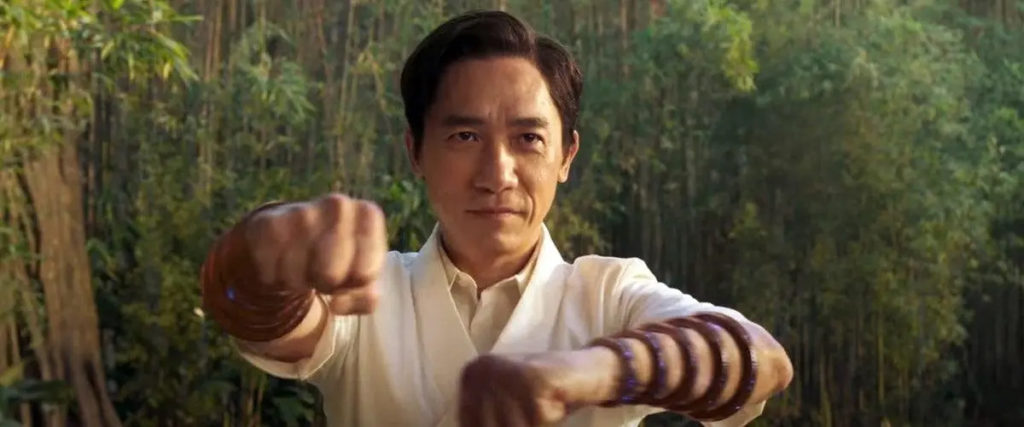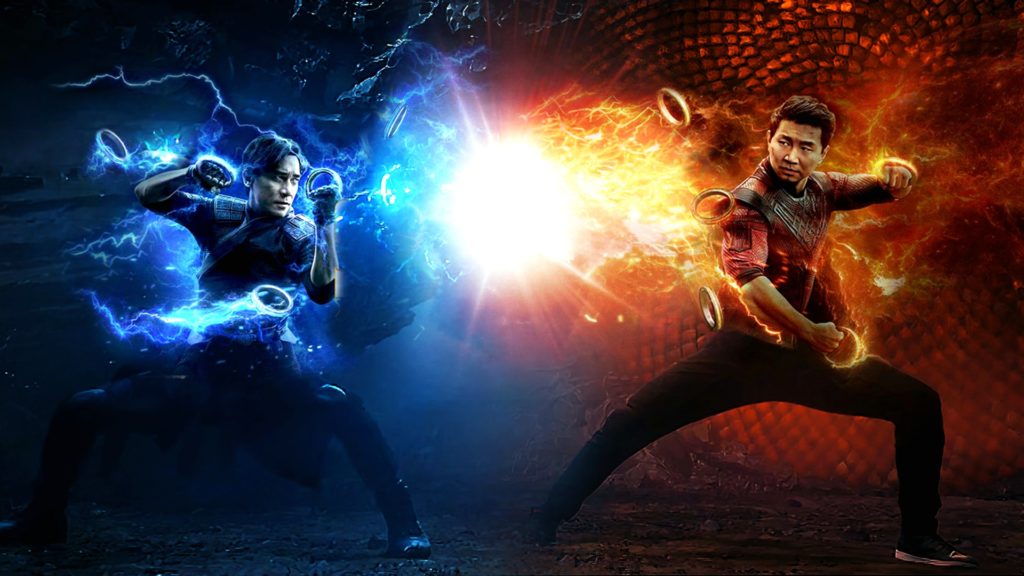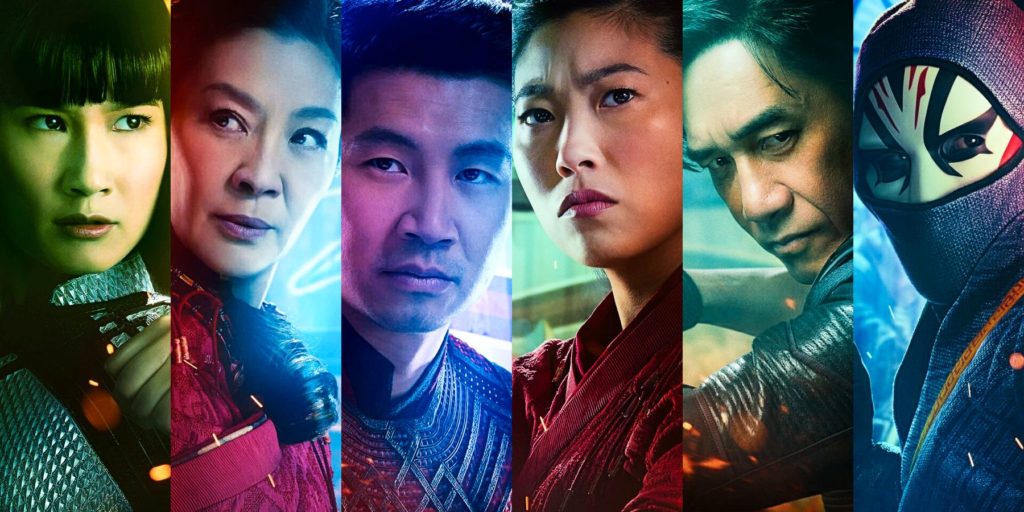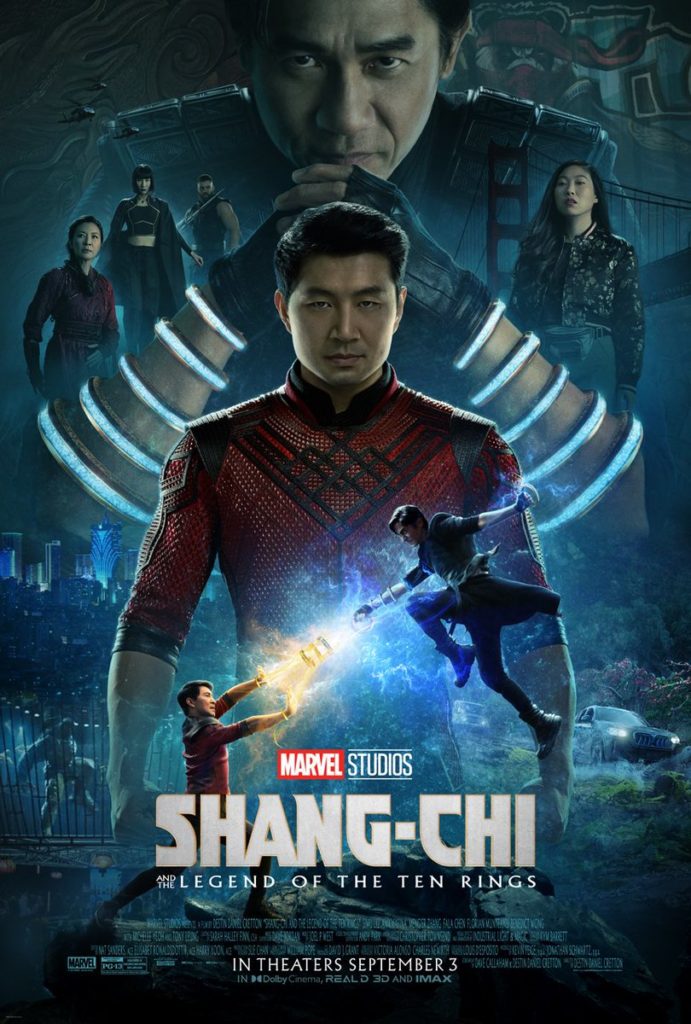在十三年间出产了24部电影之后,漫威终于推出了第一部由亚裔导演(德斯汀·丹尼尔·克雷顿)和亚裔主演(刘思慕)合拍的超级英雄电影,试图在美国华裔文化认同方面取得与2018年《黑豹》为美国非裔群体所做出的相同的成就。事实上,这可以说是《尚气与十环传奇》这部电影最有趣的地方。整体而言,这是一部中等水平的漫威宇宙作品,除了一些伟大的动作编排外,大部分看起来都与该系列的其他电影别无二致。
在《尚气》的开头,我们看到了一个熟悉的景象。传奇演员梁朝伟以反派文武的身份庄严地映入眼帘,然后在竹林中的空地上与一位美女表演了一场诗意的、芭蕾式的武术战斗。这是一场纯洁的灵魂与堕落的灵魂之间的战斗,是一场让反派心悬一线的战斗;如果你打开电视看到这一幕,你或许会认为这是《卧虎藏龙》中的情节。但当你开始认为漫威在向这部21世纪初成功的武侠电影致敬时,魔咒突然被打破了,梁朝伟开始用他手腕上佩戴的,像大炮一样的十个臂环,发射出强大的紫色能量射线。这部电影似乎边向观众wink,边说:“你想什么呢?这是一部超级英雄电影,还记得吗?”

但这不仅仅是一部超级英雄电影,它更是一个全新故事的开端,这意味着我们必须要介绍梁朝伟在片中与自己疏远的儿子,由刘思慕扮演的主角尚气。由于观众不知道的原因,他在十几岁时离家出走,逃到了美国,并将自己的名字从尚气改为尚恩。他在一家酒店当服务生,和他最好的朋友(也是爱侣)凯蒂(由奥卡菲娜扮演)过着完美的普通生活。在影片简短地带我们了解了他们的一些日常生活(与家人的往来、在酒吧的双人约会、卡拉OK)之后,我们很感激地看到了第一个动作场景。

已故的布拉德利·詹姆斯·艾伦(Brad Allan)担任《尚气》的武术指导,他曾是成家班的一员,是好莱坞最好的第二组导演和特技协调员之一,凭借《歪小子斯科特对抗全世界》以及《王牌特工:特工学院》等电影获得了声誉。在他的专业指导下,以及《黑客帝国》资深摄影师比尔·珀普的帮助下,在巴士的第一场打斗戏是近期漫威历史上最令人耳目一新的动作戏之一。奧卡菲娜驾驶的巴士在旧金山陡峭的街道上飞驰,而刘思慕的身体素质是惊人的,他在不出汗的情况下就对付了几个坏人。这是众影片的灵感结晶,是美国电影如《生死时速》或《布利特》和中国武术电影的完美结合(如成龙自己的喜剧《警察故事》,其中有一个著名的巴士场景,显然启发了《尚气》)。
随后,尚气沿着他姐姐夏灵留下的神秘线索前往澳门。对此克雷顿采用了类似于克里斯托弗-诺兰在《蝙蝠侠前传》中使用的平行故事情节技术,由此我们在闪回中了解了主人公过去的全部故事。剧本最终让尚气与他的姐姐和父亲团聚,中途还有一些惊奇的漫威宇宙元素的出现。这个家庭的传奇故事围绕着尚气失去母亲,以及文武因她的死而深受打击的方式展开。在塔罗的隐秘山谷中的结局是一个CGI爆炸式的俗套图像,这在漫威历史上可能是迄今为止无法比拟的。

尽管这部电影中的一些元素很新鲜,但它最终感觉被自己的野心限制住了而无法腾飞。它的文化意义并不像它认为的那样强烈,因为它依赖于两点。A.李安、张艺谋或胡金铨等大师过去的武侠电影作品。B.《摘金奇缘》等现代大作的商业成功向好莱坞证明了拥有全亚裔演员是有利可图的。
从这两点中偷师,特别是在选角方面(梁朝伟、杨紫琼、奥卡菲娜、钱信伊),《尚气》试图将自己定位为一部在代表性方面向前迈出了大胆一步的原创作品,但没有什么能掩盖一个明显的事实,即制作团队并不是第一批这样做的人。事实上,这只是突出了电影的局限性。刘思慕可能是作为电影的新星出现的,但他的角色被勾勒得如此单薄,以至于在电影不断前进的过程中,他能做的只是纹丝不动地坐在乘客位上环顾四周。而另一方面,梁朝伟作为银幕上的传奇人物,惊奇地创造了漫威电影历史上最有人性的反派之一,并为这个角色带来了巨大的魅力,以至于你希望影片的名字是《文武与十环传奇》。

就像梁朝伟在影片结尾处最终试图达成的浮士德式的交易一样,感觉漫威已经与魔鬼达成了自己的协议:工作室现在有能力在弹指间买下任何它想要的演员,将任何电影传统转化为卖点,并打破所有的票房记录。但是,尽管它有能力,它却无法摆脱其专有的合家欢式幽默、自我指向性情节和爆炸性的CGI第三幕。漫威电影还是不能成为漫威电影以外的东西。

影评人简介
贝尔纳多·莱特(Bernardo Leyte),常驻巴黎的电影制作人。 他在西班牙、德国和英国长大,毕业于伦敦电影学院,目前担任导演。 他是一位充满热情的影迷,他所观看的电影囊括各种类型,从他的偶像斯坦利·库布里克(Stanley Kubrick)和安德烈·塔可夫斯基(Andrei Tarkovsky)的電影,到超级英雄、恐怖片、动漫等。

Twenty-four films and 13 years later, Marvel has released its first superhero film led by an asian director (Destin Daniel Creton) and an asian lead actor (Simu Liu), trying to achieve the same level of cultural recognition for Chinese-American culture that Black Panther did in 2018 for the African-American community. This is, in fact, the most interesting thing about Shang-Chi and The Legend of The Ten Rings, a mid-tier Marvel Cinematic Universe entry that mostly looks and feels like every other film in the series, except for some great action choreography.
Towards the beginning of Shang-Chi, we are introduced to a familiar sight. Legendary actor Tony Leung nobly enters the frame as the villainous Wenwu, and proceeds to perform a poetic, balletic martial arts dance/fight against a beautiful woman, staged in a clearing in the middle of a bamboo forest. This is a battle between a pure soul and a corrupted one, one where the villain’s heart is on the line; If you turned on the TV and saw this scene, you would think it’s something out ofCrouching Tiger, Hidden Dragon. When you start to think that Marvel has made a radical stylistic shift in its homage to the successful wuxia films of the early 2000s, the spell is broken, as Leung begins to shoot powerful purple rays of energy out of the ten arm rings he wears like cannons around his wrists. “What did you think?”, seems to be winking the film, “ This is a superhero movie, remember?”
But it isn’t just a superhero film, it’s an origin story, which means we have to be introduced to Tony Leung’s estranged son, Shaun, our protagonist, played by Simu Liu. For reasons unknown to the audience, he ran away from home as a teenager and fled to the United States, changing his name from Shang-Chi to Shaun. He now works as a valet in a hotel and lives in perfect normalcy with his best friend (and love interest) Katy, played by Awkwafina. After the film briefly takes us through some of their normal-stereotypical-existence ( family visits, a double date in a bar, karaoke) we thankfully get to the first action scene.
Shang-Chi was choreographed by the late Brad Allan, a former protégée of Jackie Chan who made his name as one of the best Second Unit directors and stunt coordinators in Hollywood, working in films such as Scott Pilgrim vs the World or Kingsman: The Secret Service. Guided by his expertise (with the helping hand of veteran Matrix cinematographer Bill Pope), the first fight scene on a bus is one of the most refreshing action moments in recent Marvel history. Simi Liu’s physicality is immediate and stunning, as he takes on a handful of bad guys without breaking a sweat, while the bus, piloted by Awkwafina, careens down the steep San Francisco streets. This is an inspired moment in the film, a perfect marriage of American films like Speed or Bullit and Chinese martial arts movies (like Jackie Chan’s own comedy Police Story, which has a famous scene with a bus, a clear inspiration for Shang-Chi).
In the present, Shang-Chi travels to Macao following a mysterious trail left by his sister, Xialing. Simultaneously, Creton employs a parallel storyline technique similar to the one used in Batman Begins by Christopher Nolan, by which we find out the full story of our protagonist in flashbacks as he moves closer to his past life. The script ultimately reunites Shang-Chi with his sister and his father, with some surprise Marvel Cinematic Universe cameos along the way. The family saga revolves around the loss of the mother of Shang-Chi, and the way Wenwu was broken by her death. Later, the finale in the hidden valley of Ta Lo is a CGI explosion of kitsch imagery which is probably unmatched to date in Marvel history.
Despite the freshness of some elements in this film, it ultimately feels too constricted by its own ambitions to ever take flight. Its cultural significance is not as strong as it thinks it is because it relies on two things: A)past hits of martial arts cinema from masters such as Ang Lee, Zhang Yimou or King Hu, and B) the commercial success of modern smash hits like Crazy Rich Asians, which proved to Hollywood that having an all-asian cast could be profitable.
Stealing from both of those worlds, especially in terms of casting (Tony Leung, Michelle Yeoh, Awkwafina, Ronnie Chieng), Shang Chi tries to position itself as an original work that takes a bold step forward in terms of representation, but nothing can hide the obvious fact that they aren’t the first ones to be doing it. In fact, this just highlights the limitations of the movie: Simi Liu may be presented as the new star of the film, but his character is so thinly sketched that all the actor can do is look around stoically as the film keeps rolling along, with him in the passenger seat. Tony Leung, on the other hand, being the screen legend that he is, creates one of the most human villains in MCU history out of thin air and brings such charisma to the role that you really wish the film’s title was Wenwu and the Legend of The Ten Rings instead.
Much like the Faustian bargain that Leung ultimately attempts to make in the film’s finale, it feels like Marvel has made its own deal with the devil: the studio now has the power to buy any actor it wants with the snap of a finger, to transform any film tradition into a selling point and to break every box office record but, for all its power, it can’t break away from its patented formula of family friendly humour, self-referential episodes and explosive CGI third acts. A Marvel movie cannot be anything other than a Marvel movie.

About the Author
Bernardo Leyte (Vigo, Spain) is a Paris-based filmmaker. He grew up in Spain, Germany and the UK, graduating as a director from the London Film School. He is a passionate cinephile whose eclectic film playlist includes a bit of everything, from his idols, Kubrick and Tarkovsky, to superheroes, horror, anime and everything in between.

